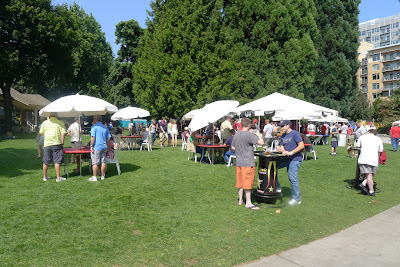Look, sports marketing is hardly a new concept with the macros. They've been working to link themselves with popular sports for a long time. What's different today is their aggressiveness. Back in the olden days, they mostly just bought advertising. Today, they want their logos to be ever-present in and around sports venues. And not just in pro stadiums.
 |
| Point of purchase display at Freddy Meyer |
Being a Washington State alum, I don't like seeing the Duck logo on anything. They have a lot of advantages in money, facilities and talent. Now an official beer partner, albeit a crappy macro beer? Another prize for Oregon, I figured. Too bad it turns out this problem, if that's what it is, goes deeper than the Ducks. Because Coors has deals with half of the Pac-12, including Washington State.
 |
| Now the NFL's Official Beer Sponsor |
While we're on the subject, you may wonder why light beers are the ones partnering up. Why not Budweiser or Coors Banquet Beer? The answer is that light beer is the only segment in the macro portfolio that continues to perform reasonably. Virtually everything else is in free fall, being driven out of the marketplace principally by craft beer.
 |
| The 2011 list of Coors schools |
Anyway, Coors launched the effort to expand its reach into college sports as the NFL contract expired in 2011. About a year ago, it announced deals with 23 schools (Oregon was not on that list). To be fair, some of these deals were rollovers of existing contracts. In others, Coors Light replaced a competitor (I wonder who that could be?) or became a first-time partner.
The way it works seems simple. In exchange for money (industry sources say more than $10 million is being funneled into this program) Coors gets to use team logos and related visuals in point-of-purchase retail displays and other signage.
There are some restrictions. Coors is not allowed to use school marks on bottles, cans or packaging of any kind. And they can't use an actor to portray an athlete or likeness of an athlete in any promotional vehicle or ad. (More details here.)
What are the schools getting in return? Over and above whatever cash they got to sign on, you'll see co-branded promotional materials and advertisements all over the place. In effect, Coors will help schools promote their teams.
Part of that program incorporates what Coors refers to as its "strong responsibility message." I suspect this message is a big part of the reason they've been able to tap into the college market, where many, if not most of the fans, are not of legal drinking age.
To prop up this campaign, Coors ran a series of "responsibility messages" during Pac-12 games last year and will do something similar this year. If you look closely at the point of purchase display in the top photo, you'll notice the "21 Means 21" messaging at the bottom left of the poster. It also says "Great Beer, Great Responsibility." Not to demean the responsibility message, but the great beer claim is pretty lame. Coors Light is not close to a great beer.
Craft beer brands, as noted at the outset, are pretty much locked out of deals like the one launched by Coors simply due to money. Coors spends lavishly to promote a product of questionable quality; craft brewers spend lavishly to create a quality product and advertise little.
As diametrically opposed as their approaches are, we should not forget that Coors once did the craft beer movement in Oregon a big favor...unwittingly or not. I'll be looking back at what they did and how it benefited the craft movement in an upcoming post. Watch for it.
























